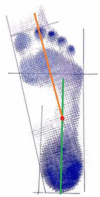Footprint Curvature in Spanish Women: Implications for Footwear Fit
- PMID: 32183182
- PMCID: PMC7142565
- DOI: 10.3390/ijerph17061876
Footprint Curvature in Spanish Women: Implications for Footwear Fit
Abstract
The incorrect adjustment of footwear produces alterations in the foot that affect quality of life. The usual measurements for shoe design are lengths, widths and girths, but these measures are insufficient. The foot presents an angle between the forefoot and the rearfoot in the transverse plane, which is associated with foot pronation, hallux valgus and metatarsus adductus. Here, we aimed at identifying the groups formed by the angulations between the forefoot and rearfoot using a sample of footprints from 102 Spanish women. The angle between the forefoot and rearfoot was measured according to the method described by Bunch. A cluster analysis was performed using the K-means algorithm. Footprints were grouped into three types: curved, semi-curved and straight, according to the degrees of angulation between the forefoot and rearfoot. There is great variability in the morphology of the foot. Based on our findings, to achieve a better footwear fit, we propose the manufacture of three types of lasts with different curvatures.
Keywords: anthropometry; clustering; foot diseases; shoes.
Conflict of interest statement
The authors declare no conflicts of interest.
Figures
References
-
- Bunch R.P. Foot measurement strategies for fitting athletes. J. Test. Eval. 1988;16:407–411.
-
- Rodríguez-Sanz D., Tovaruela-Carrión N., López-López D., Palomo-López P., Romero-Morales C., Navarro-Flores E., Calvo-Lobo C. Foot disorders in the elderly: A mini-review. Disease-a-Month. 2018;64:64–91. - PubMed
Publication types
MeSH terms
LinkOut - more resources
Full Text Sources



